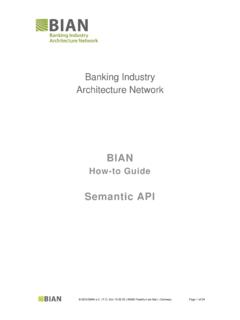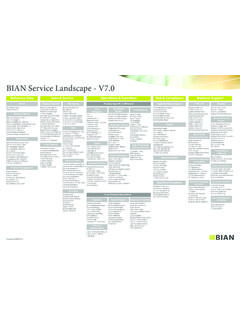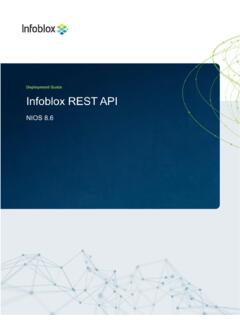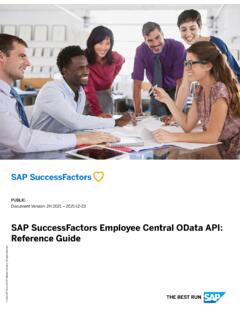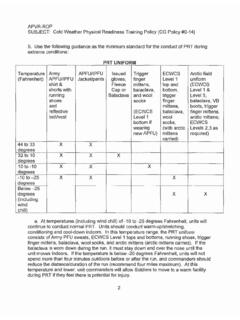Transcription of Bian Semantic API Pactitioner Guide
1 BIAN Semantic API Practitioner Guide 2020 BIAN | Frankfurt, Westend Fair | Friedrich-Ebert-Anlage 36 | 60065 Frankfurt am Main | Germany 1 Banking Industry Architecture Network BIAN Semantic API Practitioner s Guide BIAN Semantic API Practitioner Guide 2020 BIAN | Frankfurt, Westend Fair | Friedrich-Ebert-Anlage 36 | 60065 Frankfurt am Main | Germany 2 Organization Authors Role Name Company BIAN Lead Architect Guy Rackham BIAN Status Status Date Actor Comment / Reference DRAFT December 2019 BIAN Membership reviews Revised June 2020 Approved BIAN Architectural Committee Version No Comment / Reference Date First version (for limited release) July 2020 BIAN Semantic API Practitioner Guide 2020 BIAN | Frankfurt, Westend Fair | Friedrich-Ebert-Anlage 36 | 60065 Frankfurt am Main | Germany 3 BIAN Semantic API Practitioner Guide 2020 BIAN | Frankfurt, Westend Fair | Friedrich-Ebert-Anlage 36 | 60065 Frankfurt am Main | Germany 4 Copyright Copyright 2020 by BIAN Association.
2 All rights reserved. THIS DOCUMENT IS PROVIDED "AS IS," AND THE ASSOCIATION AND ITS MEMBERS, MAKE NO REPRESENTATIONS OR WARRANTIES, EXPRESS OR IMPLIED, INCLUDING BUT NOT LIMITED TO, WARRANTIES OF MERCHANTABILITY, FITNESS FOR A PARTICULAR PURPOSE, NONINFRINGEMENT, OR TITLE; THAT THE CONTENTS OF THIS DOCUMENT ARE SUITABLE FOR ANY PURPOSE; OR THAT THE IMPLEMENTATION OF SUCH CONTENTS WILL NOT INFRINGE ANY PATENTS, COPYRIGHTS, TRADEMARKS OR OTHER RIGHTS. NEITHER THE ASSOCIATION NOR ITS MEMBERS WILL BE LIABLE FOR ANY DIRECT, INDIRECT, SPECIAL, INCIDENTAL OR CONSEQUENTIAL DAMAGES ARISING OUT OF OR RELATING TO ANY USE OR DISTRIBUTION OF THIS DOCUMENT UNLESS SUCH DAMAGES ARE CAUSED BY WILFUL MISCONDUCT OR GROSS NEGLIGENCE. THE FOREGOING DISCLAIMER AND LIMITATION ON LIABILITY DO NOT APPLY TO, INVALIDATE, OR LIMIT REPRESENTATIONS AND WARRANTIES MADE BY THE MEMBERS TO THE ASSOCIATION AND OTHER MEMBERS IN CERTAIN WRITTEN POLICIES OF THE ASSOCIATION.
3 BIAN Semantic API Practitioner Guide 2020 BIAN | Frankfurt, Westend Fair | Friedrich-Ebert-Anlage 36 | 60065 Frankfurt am Main | Germany 5 Table of Contents 1 Contents & Introduction .. 9 2 Some Key BIAN Design Considerations .. 12 Why bother with BIAN? .. 12 BIAN uses an Asset Leverage Model View .. 14 Component Vs Process Business Designs an example for comparison .. 17 The BIAN Service Domain Some Example Definitions .. 19 Service Domain Encapsulation .. 23 3 The BIAN Design Artifacts .. 26 The BIAN Service Landscape .. 26 BIAN Service Domain Specifications .. 27 Service Domain Functional Patterns .. 28 Service Domain Asset Types & Right-sizing Service Domains .. 29 Service Domain Control Records .. 32 Control Record Behavior Qualifiers .. 33 Service Domain Service Operations & Action Terms .. 35 Service Domain First Order Connections.
4 39 Service Domain Information Profile .. 41 The Figure 8 Diagram .. 45 BIAN Business Scenarios .. 46 BIAN Wireframe .. 49 BIAN Semantic APIs (REST Mapping and the BIAN Semantic API Portal) .. 52 Service Domain Event Triggering (Proposed design extension) .. 58 4 Implementation Approaches .. 62 Key Properties of Component Design .. 63 Components & The Main Driver for Componentization .. 64 Information Architecture - Contrasting Component & Process Approaches .. 67 Communications Component Support for Standard Services .. 74 Adding Implementation Detail .. 78 Conceptual Requirements .. 78 Logical Designs .. 80 Physical Specifications .. 87 Implementation Approaches .. 90 Legacy Wrapping Approaches .. 91 General Approaches (for legacy wrapping & greenfield development) .. 96 BIAN Semantic API Practitioner Guide 2020 BIAN | Frankfurt, Westend Fair | Friedrich-Ebert-Anlage 36 | 60065 Frankfurt am Main | Germany 6 Attachments.
5 104 ATTACHMENT A Action Terms Related to Functional Patterns .. 105 ATTACHMENT B Right-sizing a Service Domain .. 109 BIAN Semantic API Practitioner Guide 2020 BIAN | Frankfurt, Westend Fair | Friedrich-Ebert-Anlage 36 | 60065 Frankfurt am Main | Germany 7 Table of Diagrams Figure 1 - Comparing Componentized Industries .. 11 Figure 2 - Example Navigational Model View of a Town .. 14 Figure 3 - A Service Domain Does Something to Something .. 16 Figure 4 - Process Vs Component Model View .. 17 Figure 5 - Process Vs Component Model of a Mortgage Application .. 18 Figure 6 - The Functional Patterns and Asset Decomposition Hierarchy .. 21 Figure 7 - Two Service Landscape Formats with Business Areas/Domains Highlighted 27 Figure 8 - BIAN Functional Patterns with Descriptions .. 28 Figure 9 - BIAN Functional Pattern Generic Artifacts .. 29 Figure 10 - Top Level BIAN Asset Types.
6 30 Figure 11 - Excel Extract of Service Domain Control Record .. 33 Figure 12 - Functional Pattern/Generic Artifacts and Behavior Qualifier Types .. 34 Figure 13 - Party Reference Data Directory Control Record .. 35 Figure 14 - Action Terms with Definition and 36 Figure 15 - Default Action Terms .. 38 Figure 16 - A Business Scenario with Nested Service Exchanges .. 40 Figure 17 - The Information Profile Top Level with Content Descriptions .. 42 Figure 18 - The Fractal Nature of the Information Profile .. 43 Figure 19 - Service Domain Key Properties .. 45 Figure 20 The Figure 8 Diagram .. 46 Figure 21 - Example Mortgage Business Scenario .. 48 Figure 22 - Simple Wireframe for the Mortgage Application Scenario .. 50 Figure 23 - Customer Servicing Wireframe with Mortgage Scenario Highlighted .. 51 Figure 24 - REST Archetype mapping to BIAN Generic Artifact .. 55 Figure 25 - BIAN API End Point Format .. 57 Figure 26 - Four Quadrants two Dimensions.
7 62 Figure 27 - Example of a Stand-alone Application and Operational Reuse .. 65 Figure 28 - Database Related to the Process Model 70 Figure 29 - Process CRUD linked to Service Domain Information Governance .. 71 Figure 30 - BIAN Mortgage Application Business Scenario (repeated) .. 82 Figure 31 - Two Distribution Options .. 85 Figure 32 - Application Cluster .. 86 Figure 33 - Functional Patterns Mapped to SW Techniques & Utilities .. 89 Figure 34 - Scope of BIAN Against the Conceptual/Logical & Physical Layers .. 90 Figure 35 - Parallel Core Service Domain Migration .. 96 BIAN Semantic API Practitioner Guide 2020 BIAN | Frankfurt, Westend Fair | Friedrich-Ebert-Anlage 36 | 60065 Frankfurt am Main | Germany 8 Figure 36 - Eliminating Service Exchanges .. 97 Figure 37 - Shared Platform for Consolidated Reporting .. 98 Figure 38 - Three Types of Access .. 99 Figure 39 - Three Types of Access Schema.
8 100 Figure 40 - Contrasting Type 3 and Type 1 & 2 Access .. 101 Figure 41 - External Access Framework Wireframe .. 102 BIAN Semantic API Practitioner Guide 2020 BIAN | Frankfurt, Westend Fair | Friedrich-Ebert-Anlage 36 | 60065 Frankfurt am Main | Germany 9 1 Contents & Introduction Contents This Guide describes the techniques for systems technical leads and architects to interpret and apply the BIAN Semantic APIs. It covers both legacy system enhancements and new system development. It is set out as follows: 1. Introduction why use BIAN Semantic APIs for development? 2. Some Key Design Considerations explains the key design properties of the BIAN standard that technical leads and architects need to be aware of 3. The BIAN Specification describes the BIAN design artifacts available for technical leads and architects: a. The BIAN Service Landscape b. BIAN Service Domain Specifications i.
9 Functional Patterns ii. Asset Types & Right-sizing Service Domains iii. Control Records iv. Behavior Qualifiers v. Service Operations and Action Terms vi. Service Domain First Order Connections vii. Service Domain Information Profile viii. The Figure 8 Diagram c. BIAN Business Scenarios d. BIAN Wireframes e. BIAN Semantic APIs (The BIAN Semantic API Portal) f. Service Domain Event Triggering (proposed future BIAN extension) 4. Applying BIAN designs in different implementation contexts Development covers both back-office transaction systems and interactive and decision oriented front-office customer facing systems. Approaches combine integrating with conventional process based designs and developing more advanced container based architectures: PART 1 Key Properties of Component Design clarifying the key development implications of adopting a component architecture PART 2 - Adding Detail to the BIAN Service Domain Specifications extending the BIAN Semantic conceptual designs for implementation PART 3 - Implementation Approaches detailing specific approaches to physical application designs that leverage the component model BIAN Semantic API Practitioner Guide 2020 BIAN | Frankfurt, Westend Fair | Friedrich-Ebert-Anlage 36 | 60065 Frankfurt am Main | Germany 10 Introduction The financial services industry is experiencing intense pressure as the status quo is challenged by: sweeping regulatory changes; the proliferation of advanced technologies.
10 And, FinTechs testing traditional banking models. Finally, it seems many banks are ready to confront the severe limitations of their aging systems. At the same time, they seek to position themselves to compete with new and emerging banking practices. Information technology represents both a significant constraint and a key enabler for banks during this period of radical transformation. But there is a fundamental technology challenge: most legacy systems and even many more recent system developments have been designed to streamline and automate highly structured banking processes. Over time the cycle of incremental process automation has resulted in increasingly fragmented and overlapping application portfolios as new process oriented solutions have simply been superimposed on existing processing facilities. To break this cycle both to repurpose legacy systems and integrate new advanced solutions banks need to adopt a very different approach: one based on a componentized model of the banking business.
